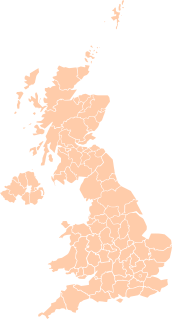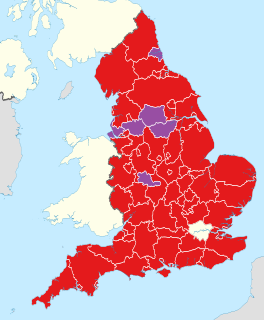
National nature reserves in England are designated by Natural England as key places for wildlife and natural features in England. They were established to protect the most significant areas of habitat and of geological formations. NNRs are managed on behalf of the nation, many by Natural England itself, but also by non-governmental organisations, including the members of The Wildlife Trusts partnership, the National Trust, and the Royal Society for the Protection of Birds.

Lieutenancy areas are the separate areas of the United Kingdom appointed a lord-lieutenant – a representative of the British monarch. In many cases they have similar demarcation and naming to, but are not necessarily conterminate with, the counties of the United Kingdom.
Chapman codes are a set of 3-letter codes used in genealogy to identify the administrative divisions in the United Kingdom, Ireland, the Isle of Man and the Channel Islands.
A lord-lieutenant is the British monarch's personal representative in each lieutenancy area of the United Kingdom. Historically, each lieutenant was responsible for organising the county's militia. Lord-lieutenant is now an honorary titular position usually awarded to a retired notable person in the county.

A Scout County is an administrative division within The Scout Association of the United Kingdom. There are currently 115 Counties and Areas in the United Kingdom. These bodies are responsible for providing programmes and support for their member Scout Districts.

Metropolitan and non-metropolitan counties are one of the four levels of subdivisions of England used for the purposes of local government outside Greater London and the Isles of Scilly. As originally constituted, the metropolitan and non-metropolitan counties each consisted of multiple districts, had a county council and were also the counties for the purposes of Lieutenancies. Later changes in legislation during the 1980s and 1990s have resulted in counties with no county council and 'unitary authority' counties with no districts. Counties for the purposes of Lieutenancies are now defined separately, based on the metropolitan and non-metropolitan counties.
England is divided by a number of different regional schemes for various purposes. Since the creation of the Government Office Regions in 1994 and their adoption for statistical purposes in 1999, some historical regional schemes have become obsolete. However, many alternative regional designations also exist and continue to be widely used.
The Custos rotulorum, Latin for "keeper of the rolls" within civil government, is the keeper of the English, Welsh and Northern Irish county records. The Custos is also the principal Justice of the Peace of the county and keeper of the records of the sessions of the local courts and, by virtue of those offices, the highest civil official in the county. The position is now largely ceremonial and generally undertaken by the Lord Lieutenant of the county.

In the United Kingdom, a county show is a summer outdoor agricultural show. The events have competitions, with prizes awarded by judges, allowing farmers and breeders to show off their cattle or crops. There are many trade stands which offer the latest farming machinery, feeds, fertilisers and other farming products. Other trade stands and activities have been added to make the shows more attractive to locals and visitors. Often there are features such as showjumping, funfairs, falconry, military displays and food exhibitions.
The following is a list of articles about the geology of English counties:
The 2003 Cheltenham & Gloucester Trophy was an English county cricket tournament, held between 29 August 2002 and 30 August 2003. The competition was won by Gloucestershire who beat Worcestershire by 7 wickets at Lord's.
This page is based on this
Wikipedia article Text is available under the
CC BY-SA 4.0 license; additional terms may apply.
Images, videos and audio are available under their respective licenses.





